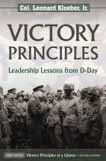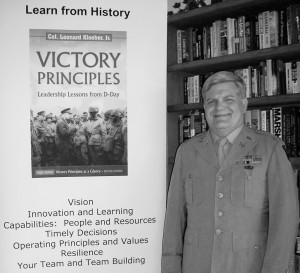Archive for the ‘learning leadership’ tag
Leadership Vision – Easy as 1, 2, 3
The requirement for having a clear vision of the future is generally recognized as a universal element of effective leadership. Without a clear vision of the future it is impossible for the leader to know where he or she is going, much less convincing their team to follow them. Followers expect that their leaders will not only have a clear vision, but that they communicate it to them before they are willing to embark with them on a risky journey into the future. So how does a leader establish a vision of for the future? It may be as simple as one, two, three.
While nothing is ever as easy as it sounds, a concept can be elegantly simple even though it takes a skilled performance to make it look easy. Such is the case of defining a leader’s vision in three simple steps:
Step 1: Describe your current state. This step requires that you are brutally honest about the current state of affairs for you and your organization, even if things are not very rosy. You need to be honest about your people, resources, problems, strengths and weaknesses. You will also need to assess your operating environment both internally and externally. Once you have an accurate current appraisal of your situation, then you can move ahead to the next step.
Step 2: Describe your future state. This should be a more pleasant part of the exercise because you are generally describing a more hopeful future for your organization and your people. It is the time to think about your goals and outcomes. What would things be like if you could wave your magic wand to shape your organization in the future? Be sure to get into details just as you did in the first step, but don’t feel constrained by the current state of affairs.
Step 3: Define “close-the-gap” strategies. Now you will need to think creatively. Answer the basic question: “How do you intend to get from point A to point B, from the current to the future state?” You may have several strategies, but you should tie them together under a “grand strategy” or a concept. The supporting strategies can define more specific approaches to certain aspects of your concept. Individual strategies can be further refined into tactics. These are more discreet steps to take for the immediate future. One aspect of your strategic approach may be to gather the right resources and capabilities. These are usually defined in two broad categories: people and resources. Getting the right people on board who have the right skills is often one of the first steps that a leader must take to move ahead. This cuts to the core of the leadership challenge. Although leaders have the overall responsibility for the success of their organization, they need to have the right team of people around them to make sure that everything that needs to get done actually does get done. Picking the right people is a key leadership responsibility. Likewise, making sure that the people have the necessary resources is also a key leader responsibility. These are often some of the first “close-the-gap” strategies, but the basic requirement in this step is to articulate the strategies and actions necessary to guide the team into the future.
So this is a simple, three-step process for defining the leader’s vision: 1) describe the current state, 2) describe the future state, and 3) define the close-the-gap strategies. The process can be more complex or take more time depending on the individual situation. Some leader’s find themselves in dire circumstances and don’t have the luxury of time to get lots of input to forge ahead. If this is the case, a leader may make a personal reconnaissance of the situation and get input from just a few key people before deciding what to do. In other circumstances, a leader might have more time because things don’t seem so desperate. In these cases leaders will often bring more people into the discussions over an extended period of time. For example, the leader might even designate several teams of people, one for each of the steps. This could be the same people or a mix of different people who are hand-picked by the leader for their expertise in a particular aspect of the discussion. How this gets done will be determined in part by the leadership style of the leader. Nevertheless, these are all just variations of the same, simple three step process. So if you become the leader of an organization or team, think about using this three step process to come up with your vision. It could be as easy as one, two, three. Best wishes in seeing your future success!
This post has been submitted for publication as an article at ezinearticles.com
To view other articles by the author:click here
Learn from History: Leadership requires a vision
Sixty-Five years ago, Allied armies under the command of General Dwight D. Eisenhower stormed the beaches at Normandy to liberate Europe and end World War II. This was and still remains one of the most complex military operations ever undertaken. It was planned and executed without the help of modern communications and computers that we now take for granted. So what can we learn from these historical events of over a half century ago that could help us today? Leadership.
The successful Allied invasion was the result of superior leadership starting with General Eisenhower, the Supreme Commander, and continued all the way down to the sergeants and junior officers that led the troops into battle. While the Germans also had some good individual leaders like Field Marshal Erwin Rommel, as a group, the did not share the same vision on how they would defend the beaches. Thus, what started as a foothold on the continent by the Allies grew into a major assault that could not be contained. The leadership provided by General Eisenhower and his subordinates became a major factor as the Allies fought together as a team. The Allies were able to eventually land enough troops and supplies while the Germans could not replace their losses. After some very difficult fighting, the American Third Army under the leadership of General Patton broke through the German lines. Once the breakout occurred the Germans were about to be surrounded. Those that could escape to fight another day retreated while the vast majority were either casualties or became prisoners of war.
The same principles of leadership used by the Allied commanders are universal leadership principles that can applied even today. Given the complex challenges facing the country, it will be excellent leadership that carries us forward to a better day, just as it did sixty-five years ago.
Today more than ever, strong leadership is required to solve the major challenges facing our country and the world. Business leaders need to provide strong leadership to their organizations in a weak economy. Others need to solve major problems on energy, health care, and global warming. Although these historic leadership lessons were forged in the heat of a desperate battle on D-Day, the common element that still remains is human nature. Leadership is the skill that gets things done, solves problems and moves us to a better day. We need effective leaders at all levels and in a cross section of business, non-profit, as well as government enterprises. Thus, the same principles that were used by Allied leaders to achieve victory then, can be used today to lead us forward.
A good example of a leadership principle in action is the concept of “vision.” General Eisenhower provided a vision of his plan for a successful invasion. The plan was known as Operation Overlord. All leaders must have a compelling vision of the future. This defines where they want to go and provides their followers an element of hope of success for the future. Although this is a simple, and perhaps obvious component of good leadership, it is easier said than done. Crafting a compelling vision requires a leader to have a deep understanding of his or her operating environment, the capabilities and limitations of their organization, and a clear understanding of their strategy for moving ahead. Good leaders involve their people to help them develop their vision. This creates organizational buy-in and builds support within the organization. Thus, vision is a fundamental component of good leadership. If you plan to be a successful leader, learn from history and make sure that you have a compelling vision to inspire your followers.
Why is leadership so important today?
Why is leadership so important today? This may seem like an obvious question when America is faced with significant challenges at home and abroad; however, in times of crisis, strong leadership is the decisive factor in driving the changes that are needed to get us to a better day. In military terms, strong leadership is recognized as a “force multiplier” and can influence the outcome of the battle. On the economy, international issues, and a host of domestic policies ranging from health care, education, and energy America needs strong leadership. We need strong leadership not just at the top, but at every level. We need leaders to step forward with creative ideas and new approaches. Throughout our history, America has been fortunate to have leaders step forward to deal with formidable problems, just as the men and women of the “Greatest Generation” stepped forward to deal with the challenges of the Great Depression and World War II. It was strong leadership then that got us through those tough challenges, and it will be a new generation of leaders today who will solve our nation’s current problems. These new leaders can learn from history and apply bedrock leadership principles that will make a difference. These are the principles that I call the “VICTORY Principles.”
The word “VICTORY” is actually a simple way to remember each of these principles. Each letter stands for one of the principles. Future posts will describe each of these principles in more detail. Check back and learn more about each of the principles and how you can apply them in your own leadership journey.
D-Day 65th Anniversary Edition Coming Soon!
VICTORY Principles is the title of a new book that will be published later this year about the D-Day invasion in Normandy, France on June 6, 1944. This book focuses on the leadership lessons learned through the examination of this historical event,one of the most important events of World War II. This year will mark the 65th anniversary of D-Day. Check back here to learn more about the VICTORY Principles and D-Day.

